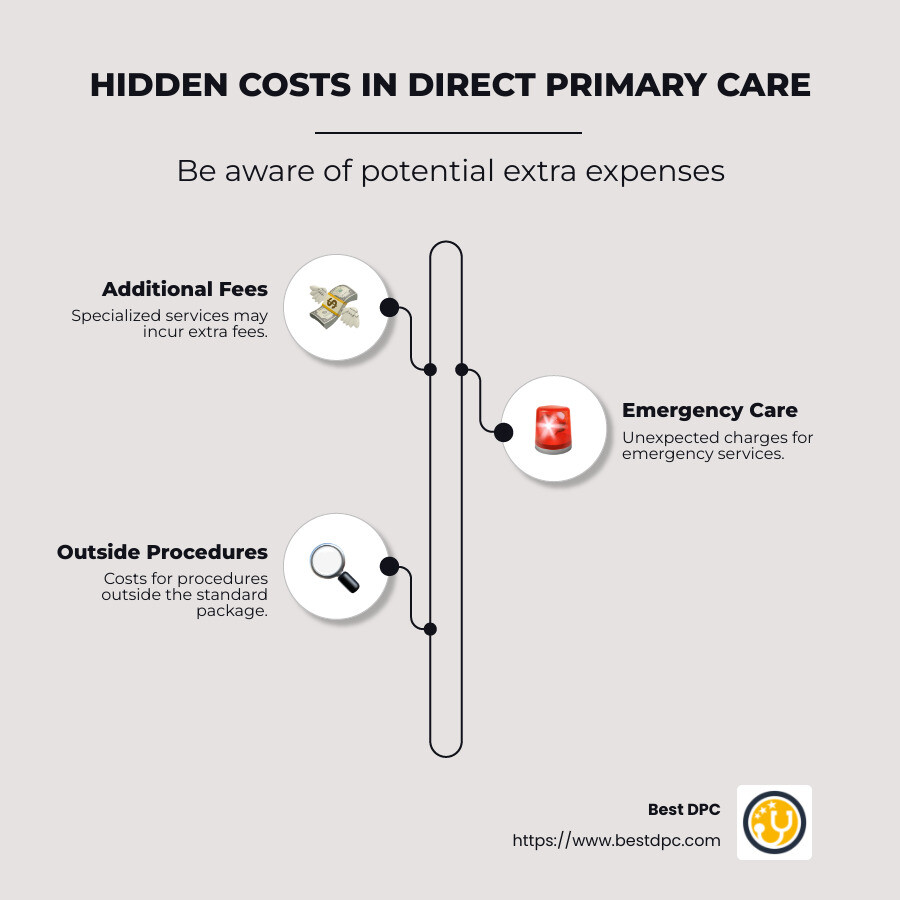Wayne Lowry

Hidden costs to watch for in direct primary care can catch patients off guard. These hidden costs might include:
Direct Primary Care (DPC) is a healthcare model designed to simplify and improve the way patients receive care. By charging a flat monthly fee, DPC eliminates the need for insurance companies to dictate your doctor visits. This fee typically covers a wide range of services like routine check-ups, preventive screenings, and chronic disease management. The focus here is on building strong, personalized care relationships between patients and their primary care providers, giving you more time and attention during each visit.
While DPC is an appealing option for many, be aware of those hidden costs to ensure you get the most out of your care without surprises. Understanding the potential financial implications can help you plan better and fully enjoy the benefits of a more direct and personable healthcare experience.


Understanding Direct Primary Care
Direct Primary Care (DPC) is a subscription-based model that changes how you pay for healthcare. Instead of dealing with insurance companies, you pay a flat monthly fee directly to your primary care provider. This fee covers most of your basic healthcare needs, allowing for a more straightforward and transparent billing process.
No Insurance Hassle
One of the standout features of DPC is that it eliminates the need for insurance for routine visits. This means no more worrying about deductibles or copays for the services included in your membership. By cutting out insurance, DPC reduces the administrative burden on doctors, letting them focus more on patient care.
Focus on Preventive Care
DPC places a strong emphasis on preventive care. This approach helps catch potential health issues early, before they become major problems. Regular screenings and check-ups are part of the plan, encouraging a proactive approach to health.
Managing Chronic Diseases
For those dealing with long-term health conditions, DPC offers valuable support in chronic disease management. By providing consistent access to your doctor, DPC ensures that you have the guidance and care needed to manage your condition effectively. This can lead to better health outcomes and a higher quality of life.
Understanding these aspects of DPC can help you see how it offers a more personalized care experience. By knowing what to expect, you can make informed decisions about your healthcare choices, ensuring that you get the best possible care without any surprises.
Hidden Costs to Watch for in Direct Primary Care
While Direct Primary Care (DPC) offers a simplified approach to healthcare, it’s important to be aware of hidden costs that might arise. These costs can catch you off guard if you’re not prepared, so let’s break down what to watch for.
Out-of-Pocket Costs
DPC covers a wide range of services with its membership fee, but not everything is included. Some procedures, like lab tests or vaccinations, might require extra payment. It’s crucial to understand what is and isn’t covered to avoid unexpected out-of-pocket costs.
Specialist Services
DPC focuses on primary care, so if you need to see a specialist, that typically falls outside the membership fee. You’ll often need to pay separately for these visits. It’s wise to ask your DPC provider about how they coordinate with specialists and what costs might be involved. This ensures you’re not surprised by additional expenses when referred to a specialist.
Emergency Services
In case of an emergency, you might have to seek care outside of your DPC practice. Emergency services are usually not covered by your DPC membership. This means you could face significant costs if you need immediate, off-plan care. Having a clear understanding of how emergencies are handled can help you plan for potential expenses.
Additional Fees
Some DPC practices might have additional fees for certain services or limits on the number of visits covered. For instance, if you need more frequent care than your membership includes, you might incur extra charges. Clarifying these details with your provider can prevent surprise bills and help you budget more effectively.

By being aware of these potential hidden costs, you can make informed decisions and manage your healthcare budget more effectively. This knowledge empowers you to enjoy the benefits of Direct Primary Care without financial surprises.
Factors Influencing Direct Primary Care Costs
When choosing a Direct Primary Care (DPC) provider, understanding what affects costs can help you make a smart decision. Let’s explore the factors that shape these costs.
Geographic Location
Where your DPC provider is located plays a big role in pricing. Urban areas, like Charleston, WV, often have higher fees due to increased rent and living costs. In contrast, DPC practices in more rural areas, such as Riverton, WY, might offer lower membership fees.
Scope of Services
The range of services included in your DPC membership also impacts cost. Some practices offer comprehensive care, including preventive screenings and chronic disease management, while others might limit services to basic primary care. More extensive services usually mean higher fees.
Physician Expertise
The experience and qualifications of the healthcare providers can influence the cost of DPC memberships. Practices with highly experienced or specialized doctors might charge more due to the added value they provide. Patients often appreciate the peace of mind that comes from knowing their care is in expert hands.
Operational Costs
Running a DPC practice involves various operational costs, such as rent, staff salaries, and technology investments. Practices with higher overhead may pass these costs onto members through increased fees.
By understanding these factors, you can better assess which DPC provider offers the right balance of cost and care for your needs.
How to Avoid Hidden Costs in Direct Primary Care
Direct Primary Care (DPC) offers a straightforward approach to healthcare with its flat monthly fee. But, to truly enjoy the benefits without unexpected surprises, it’s crucial to understand the membership details and potential extra fees.
Know Your Membership Details
Before signing up, get a clear picture of what’s included in your DPC membership. Some services, like basic check-ups and preventive care, are typically covered. However, you might encounter additional fees for services like lab tests or vaccinations.
For example, while your membership might cover routine blood pressure checks, a specialized test could cost extra. Always ask your provider for a list of covered services to avoid surprises.
Potential Additional Fees
Even with a DPC membership, there might be services not included in the flat fee. These can range from specialist consultations to emergency care. Understanding these potential costs upfront can save you from unexpected bills later.
Here’s a quick checklist to discuss with your provider:
Combining with Insurance
While DPC is designed to reduce reliance on insurance, combining it with a high-deductible health plan (HDHP) can be wise. This combo covers major medical events while DPC handles routine care. It’s a practical way to manage healthcare costs without sacrificing coverage for emergencies.
Use Health Savings Accounts
If you have an HDHP, consider using a Health Savings Account (HSA). These accounts let you set aside pre-tax dollars for medical expenses, including DPC fees. This strategy not only helps cover potential extra costs but also provides tax benefits.

By being proactive and informed, you can steer the hidden costs to watch for in direct primary care effectively. This ensures you get the most from your DPC membership without unexpected financial burdens.
Frequently Asked Questions about Hidden Costs in Direct Primary Care
What are the disadvantages of DPC?
While Direct Primary Care (DPC) offers many benefits, there are some disadvantages to consider. One of the main concerns is limited coverage. DPC primarily focuses on routine and preventive care, which means it might not cover specialist services or hospitalizations. Patients may need additional insurance for these situations, which can lead to extra costs.
Another potential downside is additional visit fees. Some DPC practices might charge extra for visits outside of regular office hours or for more complex consultations. It’s important to clarify these details with your provider to avoid unexpected charges.
Can I use insurance with DPC?
DPC typically operates outside the traditional insurance system. However, you can still use insurance for services not covered by your DPC membership. For example, insurance compatibility with DPC can be beneficial for covering specialist visits or hospital stays.
A practical approach is to pair DPC with a high-deductible health plan (HDHP). This combination allows you to use DPC for routine care while relying on insurance for major medical events. Additionally, you can use a Health Savings Account (HSA) to pay for DPC fees and other medical expenses with pre-tax dollars, offering a financial advantage.
Are there extra expenses in DPC?
Yes, there can be extra expenses in DPC. While many routine services are included in the monthly fee, some things may not be covered. For instance, specialized testing like advanced blood work or imaging might incur additional costs. Similarly, certain vaccines, especially those not typically required, might also come with an extra charge.
To manage these potential costs, it’s wise to discuss with your DPC provider what is included in your plan. Always ask about specific services like lab tests and vaccines to ensure you have a clear understanding of any additional fees you might face.
Conclusion
Best DPC is redefining healthcare by prioritizing affordability, accessibility, and personalized care. This patient-focused model eliminates the complexities of insurance, offering a straightforward, flat monthly fee for a wide range of primary care services.
By focusing on personalized care, Best DPC ensures that each patient receives attention custom to their unique health needs. This approach not only improves health outcomes but also fosters a stronger patient-doctor relationship. Patients benefit from more time with their doctors, fostering open communication and trust.
The affordability of Direct Primary Care makes it an attractive option for many. Patients avoid unexpected costs often associated with traditional healthcare models, such as copays and deductibles. Instead, they enjoy predictable expenses, which can simplify budgeting and reduce financial stress.
Accessibility is another cornerstone of the Best DPC model. By removing insurance barriers, patients can access care when they need it without the hassle of insurance paperwork. This is especially beneficial for underserved populations, offering them a reliable healthcare solution.
For those interested in exploring this innovative healthcare model, find more about Best DPC and how it can fit into your health strategy. Whether you’re looking for routine care, chronic disease management, or a more personal healthcare experience, Best DPC provides a practical and patient-centered solution.

ABOUT AUTHOR
Wayne Lowry
Wayne Lowry, Founder of BestDPC, is a passionate advocate for Direct Primary Care (DPC) and its mission to deliver personalized, accessible healthcare. He believes that DPC providers should serve as the trusted first point of contact for all medical needs, ensuring patients never feel isolated or uncertain about their health decisions. Through his work, he champions a patient-first approach to healthcare, building a system that prioritizes guidance, support, and trust.

Thank You for Registering!
Your registration was successful! We're excited to have you on board. Please check your email for a confirmation link to complete your registration.